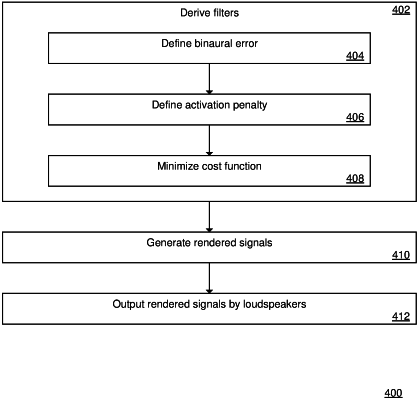| CPC H04S 7/302 (2013.01) [H04R 5/02 (2013.01); H04R 5/04 (2013.01); H04S 3/008 (2013.01); H04S 2400/01 (2013.01); H04S 2400/11 (2013.01); H04S 2420/01 (2013.01)] | 20 Claims |

|
1. A method of rendering audio, the method comprising:
deriving a plurality of filters, wherein each of the plurality of filters is associated with a corresponding one of a plurality of loudspeakers, wherein deriving the plurality of filters includes:
defining a binaural error for an audio object using the plurality of filters, wherein the audio object is associated with a desired perceived position,
defining an activation penalty for the audio object using the plurality of filters, and
minimizing a cost function that is a combination of the binaural error and the activation penalty for the plurality of filters;
rendering the audio object using the plurality of filters to generate a plurality of rendered signals; and
outputting, by the plurality of loudspeakers, the plurality of rendered signals,
wherein the activation penalty is based on a plurality of physical positions of the plurality of loudspeakers, wherein the activation penalty is a weighted sum of a power of the plurality of rendered signals, and wherein the activation penalty is based on an angular distance.
|